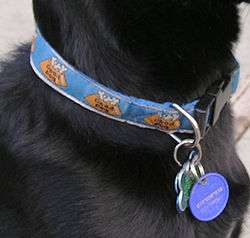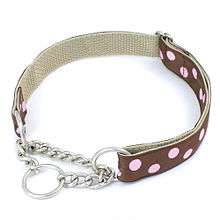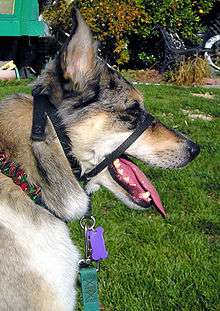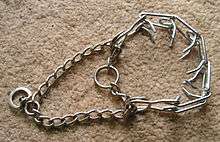Dog collar
A dog collar is a piece of material put around the neck of a dog. A collar may be used for control, identification, fashion, or other purposes. Identification tags and medical information are often placed on dog collars.[1] Collars are also useful for controlling a dog manually, as they provide a handle for grabbing. Collars are often used in conjunction with a leash, and a common alternative to a dog collar is a dog harness. Dog collars are the most common form of directing and teaching dogs.[2]
Basic collars

Collars are made with a variety of materials, most commonly leather or nylon webbing. Less common materials can include polyester, hemp, metal, or "oilcloth" (vinyl woven with cotton). Collars can be decorated in a variety of ways with a variety of materials. The basic collars for everyday wear are:
- Buckle collars, also called flat collars,[3] with a buckle similar to a belt buckle, or a quick-release buckle, either of which holds the collar loosely around the dog's neck. Identification is commonly attached to such a collar; it also comes with a loop to which a leash can be fastened. This is the most standard collar for dogs. A flat collar should fit comfortably tight on your dog's neck. It should not be so tight as to choke your dog nor so loose that they can slip out of it. The rule of thumb says you should be able to get two fingers underneath the collar.[4]

- Break-away collars look similar to buckle collars, but have a safety mechanism installed that allows the dog to break free of the collar if excessive force is applied. These collars are useful in situations where a non-quick release collar could get snagged and strangle the dog.[5]
- Safety stretch collars contain an elastic panel in the sturdy nylon collar, which allows escape from potential strangulation dangers such as branches, fences, gates and other dogs. Unlike breakaways, a stretch collar acts like a traditional collar when clipped with a leash.
Special-purpose collars and attachments
- Stud collars, also called wolf collars, protection collars, or spiked collars depending on the attachments, are collars fitted with metal studs, dulled points, or sharp points that traditionally prevented another animal from biting the dog's neck. Commonly, spikes are hand-set and tightly riveted for extra security. This type of collar dates back to ancient Greece, when dogs protecting livestock were given nail-studded collars to protect them from wolves or other predators. In modern societies, stud collars are more commonly considered a fashion accessory.
- Reflective collars, usually made with nylon webbing, incorporate reflective tape that ensures that the dog will be seen at night by approaching vehicles.
- A lighted collar (or collar light, dog light) is a collar that emits light in order to make a dog more visible in the dark to their owners and more importantly, nearby motorists. It should be noted that it is not designed to help a dog see at night, as it is well documented that dogs have very good vision in low light conditions.Most lighted collars utilize one or more light emitting diodes for the light source and can be of virtually any color, although red and blue are most common. Power is provided by one or more batteries, most common types being AAA and lithium coin cells to minimize the added weight to the collar.
- A flotation collar (or buoyant collar) is a buoyancy aid designed for dogs. Although it is not designed to be used as a life preserver or life jacket, it can provide additional buoyant support for the head of a dog when in the water. It is often used in canine hydrotherapy services to assist in the rehabilitation of injured dogs. The collar may be constructed of closed cell foam material that is inherently buoyant or be of a type that is inflated with air.
Medical collars
- Flea collars are impregnated with chemicals that repel fleas.[6] They are usually a supplementary collar, worn in addition to the conventional buckle collar.
- Elizabethan collars, shaped like a truncated cone, can be fitted on a dog to prevent it from scratching a wound on its head or neck or licking a wound or infection on its body.[7]
Training collars
Several types of collars are used for the purposes of training dogs, though sometimes a collar is not used at all (such as in the case of dog agility training, where a collar could get caught on equipment and strangle the dog). Each training collar has its own set of advantages and disadvantages (briefly outlined below) which trainers might consider before using a select one. Training collars are typically used for training only and not left on the dog's neck all the time, as some collars can be harmful or dangerous if left on a dog unsupervised.
Flat collars
Most dogs are trained on leash using a buckle or quick-release collar.
Martingale collar

Martingale collars are recommended for Sighthounds because their heads are smaller than their necks and they can often slip out of standard collars. They can, however, be used for any breed of dog. Their no-slip feature has made them a safety standard at many kennels and animal shelters. A martingale collar has 2 loops; the smaller loop is the "control loop" that tightens the larger loop when pulled to prevent dogs from slipping out of the collar. A correctly adjusted martingale does not constrict the dog's neck when pulled taut according to some who use them. Others use them fitted snugly to be able to use them in a similar manner to a choke chain but without the unlimited constriction of a choke chain. The structure allows the collar to be loose and comfortable, but tightens if the dog attempts to back out of it.
Head halters

Head halters, also called head collars, are similar in design to a halter for a horse. They are sold under several brand names, including include "Comfort Trainer",Halti, or Gentle Leader or Snoot Loop, that are also used when referring to these collars. This device fastens around the back of the neck and over the top of the muzzle, giving more control over a dog's direction and the intensity of pulling on a leash than collars that fit strictly around the neck. Pressure on this type of collar pulls the dog's head towards the handler. These type of collars can stop a strong dog pulling an owner in an unsafe direction. They are also good for dogs that pull as the pressure will no longer be directly on their wind pipe.[8]
The theory it is that if you have control of the head, you have control of the body. The head collar generally consists of two loops, one behind the ears and the other over the nose. This tool makes it more difficult for the dog to pull on its leash. This is a management tool only, it does not train the dog not to pull.
Controversy
Supporters of the head halter say that it enables the handler to control the dog's head, and makes the dog unable to pull using its full strength. It is especially useful with reactive dogs, when control of the dog's head can be a safety issue.
Those who do not recommend use of the head halter say that some dogs find it unnatural and uncomfortable. If the collar is too tight, it may dig too deeply into the skin or the strap around the muzzle may push into the dog's eyes. Cervical injury is a possible result from improper use of the head halter; if a dog is jerked suddenly by the leash attached to the head halter, the dog's nose is pulled sharply to the side, which might result in neck injury. If the nose strap is fitted too tightly, the hair on the muzzle can also be rubbed off, or the dog might paw and scratch at its face, causing injuries ranging from mere bare skin to severe abrasions.
Some head halters attach behind the neck and tighten around the nose when the dog pulls causing discomfort to deter the dog from pulling. Manufacturers tout them as safer than halters that attach below the muzzle.
These collars are considered aversive as they rely on a level of discomfort to redirect the dog. A force is applied to the side of the dog's face which causes at best an unpleasant sensation, at worst intense pain. The dog then alters its behavior to avoid this unpleasant or painful sensation.
Aversive collars
Aversive collars use levels of discomfort or an unpleasant sensation to encourage a dog to modify unwanted behaviors.[9] The use of aversive collars is controversial, with some humane and veterinary organizations recommending against them.[10][11][12]
- Shock collars (or training collars, remote training collars, e-collars, electric collars, radio-controlled collars, hunting collars) are electronic training aids developed to deliver a low intensity electrical signal, vibration, tone, or light signal to the dog via the collar. Used primarily as a means of remote communication and widely accepted as a primary tool for the training of deaf and working dogs. The "aversive" use of these collars is seen mainly in the field of containment where they have been seen as one of the most effective and least invasive of all the aversive tools since the 1980s. Attaching a leash or lead to an electronic collar can pull the contacts too close to the dog's skin, causing severe pain.
- These consist of a radio receiver attached to the collar and a transmitter that the trainer holds. When triggered, the collar delivers an aversive. The specific aversives vary with different makes of collars. Some emit sounds, some vibrate, some release citronella or other aerosol sprays, some apply electrical stimulation. A few collars incorporate several of these. Of these, electrical stimulation is the most common and the most widely used. Early electrical collars provided only a single, high-level shock and were useful only to punish undesirable behavior.[13] Modern electrical collars are adjustable, allowing the trainer to match the stimulation level to the dog's sensitivity and temperament. They deliver a measured level of aversive stimulation that produces significant discomfort and startle without risk of producing permanent physical injury when used correctly.[14] Shock collars are prohibited or restricted in some places.[15][16]

- Prong collars are a series of metal links that fit together by connecting through blunt, prongs that point inward toward the dog's neck. The design of the prong collar incorporates a chain loop connecting the ends of the prong series, such that it has a limited circumference (a martingale), unlike choke chains, which do not have a limit on how far they can constrict on a dog's neck. The leash attaches to this chain section. The limited traction of the martingale chain combined with the angle of the prongs prevents the prongs moving close enough to pinch. The collar is designed to prevent the dog from pulling by applying pressure at each point against the dog's neck. There are also prong collars that buckle and do not restrict.
- Prong collars must never be turned inside out (with the prongs facing away from the dog's skin), as this may cause injury against the body and head.[17] Plastic tips are occasionally placed on the ends of the prongs to protect against tufts forming in the fur or, in the case of low quality manufactured collars with rough chisel cut ends, irritating the skin. Like the choke chain, the prong collar is placed high on the dog's neck, just behind the ears, at the most sensitive point.[18]
- Some dogs can free themselves from prong collars with large wire looped sides by shaking their head so that the links pop out, so some trainers have come to use a second collar (usually an oversize check chain) in addition to the prong collar so if this happens the dog does not run loose.
Some dog training organisations will not allow members to use them, and they are prohibited by law in Victoria, Australia.[19]
- Force collars are leather with metal prongs staggered along the inside; similar to a prong collar.

- Choke chains (also called choke collars, slip chains, check collars, or training collars) are a length of chain with rings at either end such that the collar can be formed into a loop that slips over the dogs head and rests around the top of the dog's neck, just behind the ears.[20] When the leash is attached to the dead ring, the collar does not constrict on the dog's neck. When the leash is attached to the live ring, the chain slips (adjusts) tighter when pulled and slips looser when tension is released. Training with this leash involves a quick jerk with an immediate release, called a leash pop, snap, or correction. This is supposed to correct a dog's unwanted behavior, such as leaving the "heel" position. Pulling harder or longer on the choke chain presses on the dog's esophagus and restricts breathing.
- Cesar Milan's "Illusion collar" is a choke collar wrapped in a buckle collar.[21]
- Fur saver collars are a kind of slip chain that contain fewer and longer individual links than a close link chain, also known as a long link fur saver collar. Fur saver collars can be used both for long and short-haired breeds limiting damage to the dog's fur. It can be used for training and daily use as well. The fur saver collar can be 'locked out' preventing it from constricting by attaching the leash connector to any link within the chain, this mitigates the unlimited traction effect associated with a slip chain.
- No pull or restricting harnesses rely on a level of discomfort, force and avoidance to alter the dogs behavior. When the dog pulls, a strap within the harness tightens applying an uncomfortable pressure on the dog's body which the dog must actively alter the pulling behavior to avoid.
See also
| Wikimedia Commons has media related to Dog collar. |
References
- ↑ Clayden, Paul, ed. (2011-05-25). The Dog Law Handbook (2nd ed.). London: Sweet & Maxwell. p. 35. ISBN 978-0-414-04818-8.
- ↑ Hodgson, Sarah (2006). Teach Yourself Visually Dog Training. Wiley Default. ISBN 0-471-74989-3.
- ↑ Ogburn, Philip; Crouse, Stephanie; Martin, Frank; Houpt, Katherine (1 December 1998). "Comparison of behavioral and physiological responses of dogs wearing two different types of collars". Applied Animal Behaviour Science. 61 (2): 133–142. doi:10.1016/S0168-1591(98)00113-0.
- ↑ "Dog Collars; Which type Is best for your dog?". www.humanesociety.org.
- ↑ Monteiro, Melanie (2009). Safe Dog Handbook: A Complete Guide to Protecting Your Pooch, Indoors and Out. Beverly, Mass.: Quarry Books. p. 96. ISBN 978-1-59253-519-4.
- ↑ Cronce, P. C.; Alden, H. S. (11 November 1968). "Flea-Collar Dermatitis". JAMA: the Journal of the American Medical Association. 206 (7): 1563–1564. doi:10.1001/jama.1968.03150070101023.
- ↑ Swaim, Steven F.; Renberg, Walter C.; Shike, Kathy M. (2010-12-15). Small Animal Bandaging, Casting, and Splinting Techniques. Ames, Iowa: Wiley-Blackwell. ISBN 978-0-8138-1962-4.
- ↑ "Dog: Head Halters and Harnesses" (PDF). www.sfspca.org. Retrieved 13 June 2015.
- ↑ Humane Society. "Dog Collars: Aversive Collars". Retrieved 2014-08-01.
- ↑ Humane Society. "Dog Collars: Aversive Collars". Retrieved 2014-08-01.
- ↑ American Veterinary Society of Animal Behavior. "AVSAB Position Statement The Use of Punishment for Behavior Modification in Animals" (PDF). Retrieved 2014-08-01.
- ↑ San Francisco SPCA. "Trade in Your Pronged Dog Collar". Retrieved 2014-08-01.
- ↑ Lindsay, 2005, p. 583
- ↑ Lindsay, 2005, p. 584
- ↑ "Ogmore illegal shock collar dog owner gets £2,000 fine". BBC News. 18 July 2011.
- ↑ Victorian Consolidated Regulations (2008). "Prevention of Cruelty to Animals Regulations 2008 - SECT 17". Retrieved 2 December 2012
- ↑ "Herm Sprenger Prong Collar Covering Caps". Luvmydog.co.uk. Retrieved 30 December 2011.
- ↑ "How to fit a Prong Collar". Leerburg. Retrieved 30 December 2011.
- ↑ Victorian Consolidated Regulations (2008). "Prevention of Cruelty to Animals Regulations 2008 - SECT 9". Retrieved 2 December 2012
- ↑ "Dictionary of Dog Collar Terms". bigdogboutique.com. Retrieved 12 August 2012.
- ↑ "Illusion collar". Retrieved 2014-08-01.